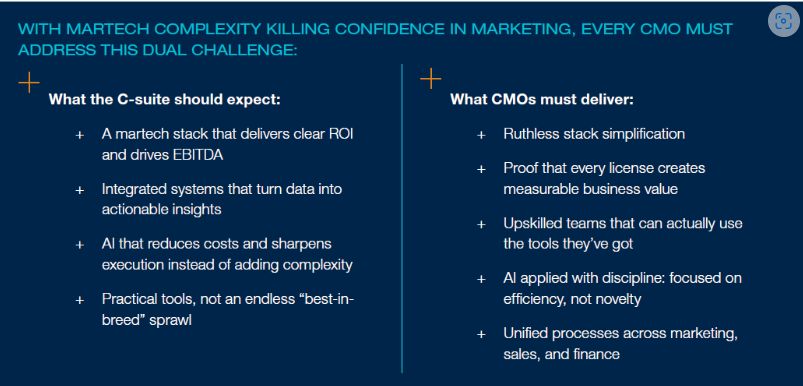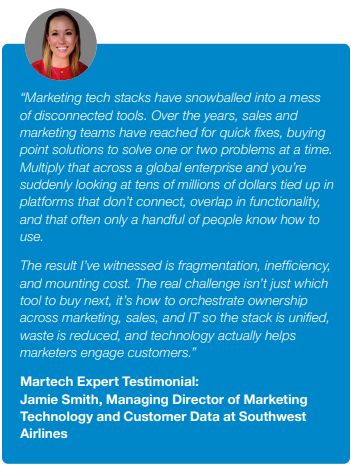- within Technology topic(s)
- with Inhouse Counsel
- in United States
- with readers working within the Retail & Leisure industries
Marketing has lost the benefit of the doubt. 65% of CEOs don't trust their CMOs.1 It's time to shake things up. And the martech stack is the most visible, most expensive, and most underperforming piece of the puzzle.
Meet the new CMO. On day one, they think the job is about vision. It's really about survival. Before they can settle in, the questions come fast:
- The CEO leans forward: "We're burning money on martech. What are we getting for it?"
- The CFO cuts in: "Don't tell me about impressions or AI pilots. Show me margin impact."
- The CIO adds: "All I see in your stack is too many platforms, zero integration, and rising costs."
- The board exchanges glances: "Average CMO tenure is 18 months. Let's see how long this one lasts."
The job has never been tougher. Modern CMOs are expected to do more than manage campaigns. They're asked to drive growth, align with cross-functional teams, and prove marketing's impact on revenue. Data, platforms, and AI have become core to the role, forcing CMOs to be fluent not just in brand, but in performance metrics, martech stacks, and AI-powered decision-making.2 This is the reality for today's marketing leaders. Not a trusted seat at the table, but widespread responsibility and a credibility gap driven by bloated, underperforming marketing technology.
CMOs inherit fragmented martech stacks of 100+ tools, most barely used, and marketing teams that operate only at 35% capacity on the platforms they have.3 While AI pilots scatter across departments, ROI remains elusive. Data sits in silos, disconnected from the business outcomes leadership needs to see.

To navigate this crisis, CMOs must solve two core problems: tech sprawl without results and software without skills. How should they do that? Simplify their martech stacks and place business accountability above all else. Fail here, and you don't just waste money. You lose whatever trust is left. And once that's gone, you'll soon follow
1. C-SUITE QUESTIONS THAT WILL MAKE OR BREAK YOUR STACK
Martech was meant to simplify marketing. Instead, it has multiplied costs, complexity, and confusion. What was once sold as the engine of efficiency has become one of the biggest reasons the C-suite doubts marketing's value.
Unchecked tech sprawl and chronic underinvestment in people have created a credibility crisis. These are the problems driving the questions your C-suite is already asking. How you answer them will determine whether or not you and your stack survive.
Here's what the C-suite is asking and what you need to keep in mind to make sure your answers land.
PROBLEM 1: TECH SPRAWL WITHOUT RESULTS
The average enterprise now runs more than 120 marketing tools.4 Each purchase may have made sense at the time—a tool for social listening, one for analytics, another for personalization—but together they've created a patchwork stack with no clear strategy. Now AI is adding fuel to the fire. Instead of simplifying, it's accelerating the chaos.

"Why are we spending so much on all these marketing tools? How is that investment paying off in terms of growth, savings, and, ultimately, EBITDA?"
Over 60% of CMOs admit they can't prove their martech investments drive business results.5 To executives, the stack just looks like bloat. Leaders need to see CMOs cut unnecessary costs and spend only on tools that deliver measurable impact. Clicks don't pay bills. CEOs and CFOs want proof of contribution to pipeline velocity, revenue growth, and margin protection.6 If you can't show it, expect budget cuts. Anything that can't be tied to EBITDA is at risk.
"Is our martech stack built for scale and integration, or is it just complexity without capability?"
Stacks balloon around CRMs and automation platforms, but without integration, data sits in fragments with no single system of truth. A shift is already under way: Custom-built or modular platforms rose from 2% to 10% of B2B stacks in 2025.7 The signal is clear: Show integration, not expansion.
"What's our AI plan? Is it saving money or just adding costs?"
AI adoption is surging: 68% of organizations now use generative AI tools in their stacks, but only 50% say they're even somewhat effective. Poor governance turns AI into just another expensive layer, stacking costs in training, maintenance, and vendor overlap. The board wants to see automation that reduces cost and accelerates performance, not hype-driven experiments.
PROBLEM 2: SOFTWARE WITHOUT SKILLS
Marketing has bought tools faster than it has built talent. With 60% of the global workforce expected to need upskilling or reskilling because of automation and AI,8 marketing teams are already too far behind the curve.

"Before we keep investing, how confident are we that our teams can leverage the tools we've got today?"
Only 28% of marketers believe their teams are fully trained to use their stack effectively.9 Expansion without consolidation is a red flag to finance leaders. For CEOs, whose top priorities in 2025 include cost reduction and operational resilience,10 it's evidence of poor discipline. Most marketers struggle to use even a third of their stack's functionality, with tool utilization rates sitting at about 33%,11 wasting licenses and wasting budget. From the C-suite's perspective, every underused login is another reason to cut marketing spend. They need CMOs to justify every dollar.
"Are we investing in our talent or just more tech?"
Training marketers to click the right buttons isn't enough. Most teams can follow workflows, but few know how to use tools to think strategically, connect data to revenue, and shape smarter decisions. Martech should be an extension of human capability, not a crutch. Companies that treat martech as a strategic discipline, backed by enablement programs, deliver higher ROI and faster innovation cycles.12 Leaders want to see CMOs elevate their people into marketers who can use technology to amplify insight, accelerate innovation, and drive growth. Anything less looks like excuses hidden behind new purchases.
"Are we preparing our teams for the roles AI is creating, not just the ones it's replacing?"
Adoption isn't enough. CEOs now expect AI-enabled personalization, predictive analytics, automation orchestration, and data-driven decision-making. Companies embedding AI expertise directly into their marketing teams are already outperforming those that don't. Marketers must become orchestrators, not operators. Instead of spending hours configuring campaigns, tagging leads, or managing budgets, AI agents can take on those tasks, freeing time for strategy, creativity, and governance. The real advantage will come from prompting, overseeing, and steering AI outputs. Teams stuck at "buttonpushing" will be left behind.
The bottom line: The C-suite has lost patience. If you can't answer these questions with clarity, confidence, and evidence, then you, your martech stack, and your budget will be on the chopping block.
2. A 90-DAY ACTION PL AN FOR THE CMO
The C-suite doesn't want promises. It wants proof and wants it now. Another glossy roadmap won't fix stack bloat or talent gaps. What's expected is ruthless action: a plan that eliminates waste, sharpens skills, and proves value in business terms. Forget the five-year vision. Results can't wait.
Stop piling up tools. Start simplifying your stack and training your people to use it.
With this 90-day action plan, CMOs can prove discipline, cut costs, and win back credibility from day one.


The bottom line: This is the plan that turns promises into proof. Cut the noise. Build the skills. Deliver EBITDA impact. Anything less is just more waste that the C-suite won't stand for.
CONCLUSION: THE PAYOFF OF GET TING IT RIGHT
The CMO's role has never been more complex, but complexity doesn't have to mean chaos. A disciplined approach to martech simplifies the landscape, makes marketing easier to run, and builds executive confidence.
By showing measurable progress within 90 days, you show that technology is an enabler, not a burden, and give the C-suite concrete, quantifiable proof that marketing is driving value:
- Stack size reduction: 15%–25% fewer tools
- Cost savings: 10%–20% budget reduction through license cuts and renegotiations
- Integration rate: 90%–100% of retained tools connected to core systems
- Skill proficiency: ≥80% on core platforms
- AI ROI: Documented revenue lift or cost reduction from pilots in automation or personalization
With a leaner stack and a more skilled team, the job of the CMO becomes clearer and the C-suite has a reason to trust marketing again.
CMOs have two choices:
- Simplify your stack and train your people.
- Or keep wasting money and destroy what trust you have left.
Discover ways you can optimize your martech and other services that will help you regain confidence from the C-suite at A&MPLIFY.13
Footnotes
1. Jason Galloway et al., "65% of CEOs Don't Trust Their CMOs. It's Time to Shake Things Up." Alvarez & Marsal, September 16, 2025.
2. Scott Clark, "The new CMO is part technologist, part strategist, part growth engine—and all business." CMSWire, June 23, 2025.
3. Constantine von Hoffman, "State of the Stack 2025: Homegrown martech surges as AI accelerates development," MarTech, March 25, 2025.
4. Scott Brinker, "2024 Marketing Technology Landscape Supergraphic — 14,106 martech products (27.8% growth YoY)," Chiefmartech, May 7, 2024.
5. Ayaz Nanji, "CMOs: The Top Martech Challenges for B2B Enterprises," MarketingProfs, n.d. (research conducted in December 2023).
6. "30 Martech Statistics to Elevate Your Strategy in 2025," WebFX, n.d.
7. Frans Riemersma, "Martech Landscape 2025: Growing, shrinking and reshaping all at once," MarTech, May 7, 2025.
8. "Future of Jobs Report 2025," World Economic Forum, January 2025.
9. "State of Martech & Marketing Operations Report 2025," LXA, 2025.
10. Denise Dahlhoff, "C-Suite Outlook 2025, Priorities for CMAs and CCOs," The Conference Board, n.d.
11. "State of Martech & Marketing Operations Report 2025."
12. Todd Holloway, "The MarTech Talent Shortage Is Real — And It's Slowing Businesses Down," Avalon Digital Partners, May 12, 2025
Originally published 10 November 2025.
The content of this article is intended to provide a general guide to the subject matter. Specialist advice should be sought about your specific circumstances.



